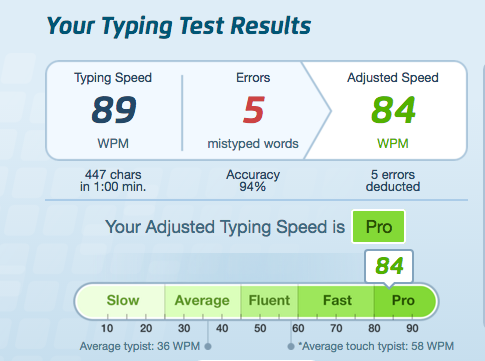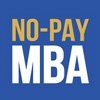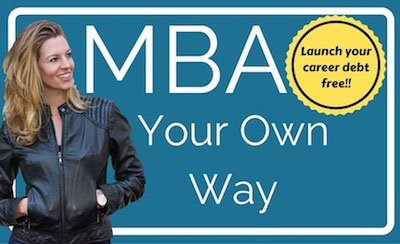by Laurie Pickard | Apr 24, 2016 | Career Development, MOOC MBA Design, Most popular posts

I am not a tech person. I do not have the mind of an engineer. I spent my childhood reading library books and pretending to be a ballerina, not taking apart electronic gadgets or building Lego towers. At one point, just before starting graduate school, I remember consciously considering what it would be like to get off the technology train and just stick with what I knew. That was in 2006.
When I started graduate school, I was decidedly tech phobic. I was studying geography, and one of the requirements of my master’s program was two semesters of geographic information systems, GIS. At that time, GIS software was quite technical, requiring knowledge of SQL, database logic, and an ability to enter terms exactly into a command bar in order to produce a result. I was terrified.
But then something remarkable happened. I took my first semester of GIS, and I actually liked it. It was a grind, the software was clunky, and it could take hours to produce single decent map, but when it worked it was amazing. Even more important than making maps, GIS helped me conquer my fear of adopting new technology.
Which is a good thing because over the next several years I got a Gmail account, joined Facebook, created my first blog, and started using cloud storage. Let’s just say it was the right decision not to drop out of technology in 2006.
One of my early maps using GIS
The thing is, these days, technology is not an option. We are all required to be tech people, at least on some level. Just for a second, allow me to channel my husband and think like an economist. If you’re studying business or planning to do so, you are trying to increase your productivity as a worker. Ultimately, increasing your productivity - the value you are able to produce in a given amount of time - is what drives your ability to command a higher salary. Productivity is a function of your skills, knowledge, and abilities in combination with the technology you are able to use.
The second half of that equation - technology - is not to be overlooked. I am not talking about your ability to create new technologies as a programmer or engineer. That is a different skill set - and a highly valuable one indeed. But no matter what your profession, and even for those of us who are much more poet than quant (myself very much included), there is absolutely no excuse for not becoming proficient at using ordinary workplace technologies.
A few words of encouragement for the technologically challenged or out of date. First, technologies have gotten a lot easier to use. Second, some of the simplest things you can do to improve your productivity are also the most impactful - like increasing your typing speed. Third, there are a TON of resources out there to help you.
The main purpose of this site is to help you get a graduate-level business education using the resources of the internet. Massive Open Online Courses (MOOCs) are the bread and butter of that undertaking. But university MOOCs don’t tend to focus much on concrete skills like making PowerPoint presentations or managing your email inbox, vital skills that you should absolutely master during your time as a business learner. Fortunately there are now plenty of ways to teach yourself new technologies, using tutorials within the programs, with YouTube videos, or with short courses on platforms like Lynda or Udemy. Throughout the rest of this article whenever I mention a technology or give a tip, I will link to an online course if there is one I know of. (FYI, some of these are affiliate links, which means I stand to earn a small commission if you make a purchase. As always, I only link to material that I think you will find useful in your business education.)
Without further ado, for anyone who is studying or considering studying business on their own, here are 6 pieces of advice on how to get up to speed, boost your productivity, and set yourself up for your technology future.
6 Ways to Become More Productive While Studying Business
1. Become a faster typist.
It sounds simple, but one of the best things you can do to improve your productivity is to become a faster typist. Most jobs today require that you engage in some form of written communication, most commonly email. If you can increase your typing speed, you can dramatically increase your overall email throughput, and that can add up to hours over the year.
The average person types about 36 words per minute. Imagine you respond to 25 emails per day, averaging 200 words per email. If you could increase your typing speed from 36 words per minute to 90 words per minute (which is fast but attainable), you could save yourself over 300 hours per year. That’s almost 8 full work weeks! Here is one of several websites where you can test your typing speed.
2. Manage your email like a pro.
I am somewhat of an email fanatic. I have three email addresses - one for my day job, one for No-Pay MBA, and one personal account. I can’t stand letting my email build up. Which is why all three of my inboxes usually look like this.

You don’t have to hit inbox zero every day, but trust me, you will feel so much better if you can figure out a way to keep your inbox to less than a page. Because I feel so strongly about this, I have started helping friends, family, and colleagues to make a fresh start using a process I call Inbox Therapy.
If you’re interested, here is my process for Inbox Therapy:
- First, go through just your first 1-2 pages of emails and move all of those that you still need to deal with in some way to a folder called ‘Important’ or ‘To do’
- Next, archive all your other emails. Seriously. All of them.
- You may then move those emails from ‘Important’ or ‘To do’ back into your inbox
- Going forward, deal with all incoming emails immediately in one of four ways - delete it (or archive it), file it, respond to it (if responding will take less than 2 minutes), or keep it in your inbox for later. (But don’t let the save for later list grow to longer than 10 at the end of the week!)
If you’d like a more in-depth treatment of email management, I suggest this course on keeping your inbox to a minimum.

3. Get good at online coordination.
Whether your team is scattered across the globe or in cubicles on the same floor, much office coordination now happens online. The ability to manage shared documents, calendar invites, video conferencing, and other coordination software is key in the modern workplace. It’s also something that we stress quite heavily in the No-Pay MBA Network, given that we have members from San Francisco to Singapore.
Below are some of the tools we use to stay organized. If you are ever planning to change jobs again, I recommend learning all of these, even if your current organization doesn’t use them. All of these technologies are widely used by businesses of all sizes, and are completely free or have a free version, so there is no excuse for not learning the basics.
Slack. The best messaging app around. Allows conversations to be organized into “channels,” which group members can opt into or out of. Integrates with everything. Gini Courter, who has taught workplace software classes for 20 years, offers this primer on Slack through the Lynda platform.
Trello. A visual project management tool that lets you put tasks onto “cards” and then move them through a workflow (e.g. to do, doing, to review, completed). Commonly used in software development, Trello has migrated to other industries. I like this beginner course on Trello, which explores some of its more commonly used features.
Zoom. I searched high and low for an affordable video conferencing program that would let larger groups participate with both audio and video. Zoom is by far the best in the biz. Functionality out the wazoo. Video conferencing is social, though, which means that you can’t just pick your favorite and only use that. What happens when someone invites you to a meeting using another technology? Coming out of a business education you should be capable of using Skype, Google Hangout, Go-To Meeting, Join.me, FaceTime or any other video conferencing program that comes your way. This is key not just for team coordination, but also for job interviews, sales calls, and networking. (But if you ever end up in a meeting that I’m hosting, be prepared to use Zoom.)
Google Calendar. Calendar invites are another small signal of your professionalism. I love Google Calendar for its ability to deal with multiple time zones - and the fact that it is free. Productivity and technology expert Jess Stratton teaches a short course on Google Calendar on the Lynda platform, which is a great place to get started.
Google Drive. I don’t mean to come across as a Google evangelist, but the suite of tools housed within Google Drive is incredible. With this free program, available to anyone with a Google account, you can create shareable documents, spreadsheets, slide presentations, and surveys. Being able to share and edit documents in real time is critical to collaboration on team projects. While there are other platforms for document sharing and collaborative editing, Google Drive is ubiquitous and free. If you ever expect to be on the job market again, you should know how to use it. Jess Stratton also offers a beginner course on Google Drive, giving you exactly what you need to start using this powerful tool.
4. Learn some basic design skills.
“Content is king,” Bill Gates declared in 1996. Those words were prophetic indeed. We have become gluttons for content, gobbling up YouTube videos, Medium articles, and BuzzFeed posts, always hungry for more. Even if it isn’t the organization’s core business, almost every organization, whether for-profit, nonprofit, or governmental, is in the business of creating content.
Individual workers, too, must create content from time to time. From the slide presentation you deliver to your extended team to drafting an email newsletter, most jobs require some ability to organize and present information visually.
But where do you start, if like me, you are graphic-design challenged? Luckily, you don’t have to learn Photoshop in order to make decent-looking visual communication products.
If you’re frustrated with Power Point, the web-based presentation program Prezi is a great alternative, allowing you to create dynamic, visually compelling presentations that capture the big picture. This course on Lynda is a good place to get started learning Prezi.
If you’re creating images for web or print, Canva is an excellent, easy-to-use, free program, also with a nice Lynda course to help you get started.
5. Employ robots to do routine tasks. (Optional)
This one I’m throwing in just for you personal productivity whizzes who are looking for a new way to up your game. A few newer apps like Zapier and If This Then That (IFTTT) allow you to sync up web applications to create automated tasks flows. For example, you can automatically save Gmail attachments to Dropbox. Or automatically create a Trello card each week for a recurring responsibility.

If you don’t do many routine tasks, you may not have an immediate use in mind for this kind of application. However, I am convinced that going forward the most productive people will be using automated workflows to do more and more of their routine work. Zapier is my favorite of the automation apps I’ve tried. I have several “zaps,” as they’re called, going at any given time. Udemy has a good starter course on Zapier if you’re interested in giving it a try.
6. DON’T STAGNATE.
This last item is more a rule than a tip. The point is that it’s not enough to master the list of popular productivity technologies of today. Rather, it is incumbent upon you to continually update your personal operating system. If you don’t, you send a not-so-subtle signal to your colleagues that you are out of date, that your skills have gotten dull. While your mind may be as sharp as ever, by ignoring or failing to learn new technologies you diminish your professionalism. Your goal is to become nimble enough with technology to continue to pick up the latest technologies throughout your career.
If you are in danger of sliding out of date, here are some habits you may want to adopt:
- Try out one new app per month. This article on the best new apps for iPhone and this one for Android are good places to start.
- Start listening to one of the many technology-focused podcasts, such as those listed here.
- Volunteer to learn a new technology and teach it to your team at work.
- If you have a hobby or side project or belong to any organizations, channel your enthusiasm for your passion project into learning a new technology - for example starting a blog site or creating a visual communication product with a new design software.
One of the best things you can do during your business education - whether self-administered or university-led - is to double down on your commitment to boosting your productivity and getting up to date on the latest technologies. That, dear readers, is my challenge to you. May you embrace it with gusto.
by Laurie Pickard | Feb 13, 2016 | MOOC MBA Design, Most popular posts
*Note: this post contains affiliate links.That means that for programs of which No-Pay is an affiliate, we stand to make a small commission if you click on a link and make a purchase. I only include links to products that I have actually used and personally endorse. I also make it clear in the body of the post which links are affiliate links. -Laurie
It’s time to come clean. No-Pay MBA first made headlines as “An MBA for less than $1000.” We’ve been flying that flag ever since. But where did that $1000 figure actually come from? Here’s where: the reporter of that first big piece about my project asked me, “How much do you plan to spend on your education?”
I answered, “$1000.”
Which at that time was my best guess of how much I would spend, not for the education itself, but for converting my website from Blogspot to a proper, search engine optimized, .com website. I hadn’t actually thought much about the cost of the actual education. Back then, you couldn’t pay for a MOOC if you wanted to. Maybe I would buy a few books? But $1000 seemed to capture people’s imaginations, and it became a good benchmark. There you have it, my dirty little secret. 😉

Now, as my No-Pay MBA is drawing to a close (I plan to “graduate” in late spring of this year), I’m finally able to take stock of exactly how much my business education has cost. This exercise has been surprisingly difficult, as it isn’t always clear which expenditures belong in the No-Pay MBA account.
For instance, I’ve paid dearly for a high-speed internet connection in Rwanda, where I have lived throughout this experience. But I probably would have paid for internet access no matter what, so the expense wasn’t solely or even primarily for my business studies. Same goes for my laptop, so I didn’t count either of those things, vital though they were to this endeavor. But other expenditures were trickier to classify. Was web hosting part of the cost of my education?
Ultimately, I came up with a few different categories of expenses that were directly or indirectly related to my business education. At the lower end, counting only the cost of the education itself, I have managed to spend under $1000, about $795 to be more precise. But I haven’t pinched pennies in this project. I am a big believer in investing in myself, my career, and my personal development. Having saved over $100,000 on business school tuition, I felt free in this project to spend on anything that might enhance the value of my education. At the higher end, counting everything I’ve put into the No-Pay MBA project, including starting a business, I estimate expenditures upwards of $19,000.
Without further ado, here is my final accounting of what I have spent to get a complete No-Pay MBA:
Direct costs of the education
I got into this MOOC thing while the gettin’ was good. Consequently, I earned a lot of course certificates while they were still free. I am about to start my first Coursera Specialization, Essentials of Corporate Finance, for which I will pay $395. I took a fabulous (and fabulously discounted) course on branding from Made Vibrant for $50. I also had a subscription to Lynda.com for about six months at $25/month, which was great for brushing up on Excel and learning more of the practicalities of managing. I also read about 20 business books, most of which are displayed here. At $10 per book, that’s about $200 on books.
(Note: No-Pay MBA is an affiliate of both Lynda and Coursera, which means that if you click on the links in the preceding paragraph, we will get a couple of bucks if you end up buying something. Same goes for the link to No-Pay MBA’s Amazon Store, where you can see my favorite business books.)
Grand total for the education itself: $795
Cost of having a basic blog site:
The next category of costs associated with my No-Pay MBA iss creating and managing a website. While having a website wasn’t part of my business education per se, it was a vital part of getting the word out about the project. The website has also been a tremendous source of inbound traffic, and so has contributed greatly to my overall experience by expanding my network. As I said earlier, I started with a simple (free) Blogspot site. A few months into the project I got more serious and purchased a .com domain at a cost of about $60. Web hosting was another $8 per month on an inexpensive hosting site. I shelled out $69 for a nice theme from Elegant Themes (another affiliate. They make some beautiful stuff!). Finally, I paid for some serious help in setting up and search engine optimizing my website. That cost about $1000. And I was in business!
Grand total for the No-Pay MBA blog site: $1321
Cost of career development and networking services:
Another key component of my education has been figuring out where I want to go with it and meeting the people who can help me get there. I am a huge believer in the value of coaching. I worked with a coach on several occasions during my education, primarily as a way of getting clarity around how to leverage my education in the course of my career. I even paid a pretty penny for one 90-minute session with a high profile executive coach. That session was so jam-packed with insight that it kept me busy for the better part of a year. Worth it, even at the cost of several hundred dollars.
The best value service I took advantage of in the career development realm was the Career Leader assessment. This comprehensive inventory cost $95, and it helped me to understand that my greatest professional interests and aptitudes lie in product development, project management, and mentoring/coaching. That insight ultimately led me to create a business centered around those elements. Well worth a hundred bucks, if you ask me!
Another big ticket item in the career development and network category is my upcoming attendance at the South by Southwest Education conference (SXSWedu). Attending an industry conference can be a great way to expand your network and introduce you to the latest greatest ideas in your field. Expensive, but again, worth it.
Grand total for career development and networking: $2050
Cost of starting a business:
Finally, by far the most expensive thing I did as part of my education was to start a business. Now, on the one hand starting a business wasn’t strictly part of my business education. It was more an outcome of the education. I’ve also earned back nearly all of the money I invested in my business within the first 8 months of operation, and I stand to be fully in the black within the next several months. But that initial outlay was significant, I could have failed, and by far the greatest value of starting a business has been educational. So in that sense, starting a business was part of my business education.
I won’t go into too much detail, but between setting up my website for ecommerce, developing the portfolio feature on the site, registering a business and establishing a trademark, and hiring an assistant to help me with all the extra work, my investment in my business was 10X the investment in the education itself.
Grand total for starting a business: around $15,000
So, as I said at the beginning of this post, depending on how you slice it, I spent somewhere between $795 and $19,000 on by business education. That might sound like a lot, but even at the upper end, it’s only about 1/10th of what many traditional business students spend on an MBA when you count all the expenses.
What should you pay for as part of your business education?
Clearly, there is quite a lot you can spend money on, even as part of a tuition-free business education. If you’re operating with limited resources, deciding what to spend your money on requires a great deal of discernment. At the risk of making this into an excessively long blog post, below are my recommendations on how to make the highest returning investment in yourself and your education.
Course content and learning
Despite Coursera’s recent changes in policy (students now have to pay to access quizzes and other assessments), there are still plenty of free courses out there. Platforms such as FutureLearn, edX, and Alison still offer many if not most of their courses for free. There’s also iTunesU, which is often overlooked given the focus on MOOCs, but they’re still offering a lot of great courses.
I’m also a fan of professional training courses through Lynda and Udemy, which are typically quite affordable and oftentimes more practical (less theoretical) than what the university MOOC providers are offering. (See sidebar banner links for special deals at both of these sites.)
When it comes to course certificates, I stand by my advice to be choosy about what you pay for. That said, a serious business student should probably do at least one rigorous series of courses all on the same topic. It may be helpful to get a certificate that covers that whole series, in case a future employer ever asks to see proof.
And let’s not forget books! I’m currently reading Managers, Not MBAs by Henry Mintzberg. It’s a great read, and it’s really gotten me thinking about what the overall purpose of business education is and ought to be. Some of my other favorites can be found here. (Full disclosure, as with some of the other links in this post, I will earn a few cents if you purchase any books after clicking on the links above.)
Career development and networking services
At the free tier, there is a lot you can do in the networking department. You should definitely have a LinkedIn account and a fully filled out profile. Free Facebook and LinkedIn groups provide some opportunities to meet professionals in your field, as do the course forums for MOOCs themselves. By far the best thing you can do to build your network is to make a habit of conducting informational interviews (more on that in a future blog post), and it doesn’t cost a penny.
If you have a little bit of money to spend, coaching can be a phenomenal investment, especially if you are feeling stuck or are at a career crossroads. I also recently learned about a service called Evisors, which is a kind of hybrid between coaching and informational interviews. The service allows job seekers to book short sessions with people who work at the companies or in the fields they are interested in.
As I mentioned earlier, I got a lot out of the Career Leader assessment. There are others like it, and they can sometimes reveal unexpected insight about where you ought to be focusing your career development efforts. Some colleges and universities offer free access to their alumni, so you may be able to get Career Leader or another assessment for free. If you don’t have that kind of access, Strengths Finder 2.0 is an affordable alternative.
Industry conferences are also a valuable way to connect with professionals in your field. If the price of admission is too high, it may be worth it to show up at the event just for the coffee dates and networking opportunities, without actually attending any sessions.
Experiential learning
Getting out of the classroom and into the real world is key to a great business education. It’s free to apply your new skills at work, and doing so may even lead to a raise (as it did in my case). Volunteering or interning with a local organization or through a virtual placement requires some work to set up, but is also generally free.
International travel, which you may be able to combine with volunteering or interning, is an important add-on to many MBA programs. International exposure is highly valuable, no matter what you plan to do. But of course, international travel can be expensive.
Starting a business is an incredible, life-changing learning experience. It’s also difficult, risky, and expensive. But if you can swing it without draining your life savings or quitting your job, starting an entrepreneurial venture can be the ultimate business education.
Finally, I would be remiss not to mention the No-Pay MBA Network, which brings together as many networking, career development, and experiential learning services as I can offer at a price under $20 per month.
How do you get the best bang for your educational buck? Let us know in the comments below!
by Laurie Pickard | Jan 17, 2016 | Career Development, MOOC MBA Design, Most popular posts

Here’s university education in a nutshell: First, the university deems me talented enough to succeed by putting me through an admissions process. Next, the university provides a series of hurdles for me to clear, primarily courses that I must complete. The courses are of varying levels of difficulty and quality, and I have a fair amount of choice over which courses I take, so my set of hurdles may be higher or lower than my classmates’, but no matter. After I complete the requirements the university has set out for me, it grants me a diploma and allows me to carry around the university’s brand name for the rest of my working life.
With the university’s stamp of approval, I am able to access higher quality and better paying jobs. Which is a pretty good thing because in exchange for this process, I have paid the university a pretty penny. I need a high-paying job in order to be able to pay off my students loans.
But what if higher education didn’t actually work like this at all? What if education were actually a transformation that occurred inside of the learner’s mind? What if professors were neither task masters nor the arbiters of my success but were rather guides in a process of transformation that I, the student, was ultimately in charge of? What if I could learn not just in the classroom but also in the real world? And what if everything I learned, no matter where I picked it up, could “count”? It sounds lovely, but of course there is a problem with this method of learning. Who will be there to attest to the change the learner has gone through?
In other words, if you direct your own education, how will future employers know that you’re qualified to hire?
This, of course, is exactly the situation at hand.

The credential problem
When I started the No-Pay MBA project, I set out to complete the equivalent of a two-year MBA program in three years of part-time study. I have used MOOCs and other free and low-cost online resources to complete this education. I based my course progression on the curricula of top-flight MBA programs. Now that I am nearing the end of my program - I expect to finish in May of 2016 - I have proven (at least to myself) that I am capable of learning what is taught in business school, even if I wasn’t willing to drop a hundred-fifty grand to do it. And I have indeed gone through an internal transformation. However, I am still left with what I have come to think of as “the credential problem.” Who will legitimize my transformation so that I can take it into the job market and be paid for it?
Ultimately, I would like for my business studies - and yours - to provide a direct pathway to increased employment prospects. But new survey data from the Graduate Management Admissions Council shows that we still have a ways to go toward that goal. Currently only 8% of recruiters in the US see MOOCs as a viable alternative to business school (other regions view MOOCs more favorably). I’ve thought about various solutions to this problem. Would a university grant me ‘credit’ for the courses I’ve taken? How much would they charge to do it? Would I be willing to pay $5,000 for that service? $10,000? Would I be willing to trade in my No-Pay MBA for a degree from a lower-tier university? Or would I hold out for a degree from a mid- or top-tier school? It seemed unlikely that the better business schools would go in for a scheme like this, and I wasn’t sure I was willing to pay even a modest sum for a lower-tier degree. I even thought briefly about creating my own credential, which I could grant to others who go through my program, but ultimately I rejected the idea. Quality control seemed much too difficult, and it seemed like a risky business overall.
The portfolio solution
The credential problem is not just my problem. Anyone who wants to leverage a MOOC-based education for career advancement faces the same issue.
Fortunately, there is a solution to the credential problem.
While MOOCs have gone on a wild roller coaster in the press, by turns hyped as the great disruptor and scoffed at as entertainment for the overeducated, a quieter revolution has been occurring in education. The serious thinkers seem to agree that the real disruptive potential rests with competency-based education, which emphasizes skills over seat-time or course completion.
Furthermore, while recruiters may be tepid towards MOOCs, fully 92% of employers say that proven ability to perform is critical to their selection of who to hire, more employers than for any other criterion.
Hence, I would like to present the portfolio solution to the credential problem. The portfolio solution says that you can legitimize what you’ve learned in MOOCs - or any other means - by demonstrating your competency, displaying what you can do for anyone who wants to know. By creating a portfolio, you can provide external evidence to anyone who wants to understand your education. No third-party validation, just direct observation of what you are able to do.
Core business competencies
When I first released the portfolio feature on No-Pay MBA, I didn’t yet have specific guidance to give about what to put in a portfolio. Having had some time to mull it over, here is my take on what a competency-based business education might look like. (Keep in mind that this is just a first draft.) Below is a list of the skills that I believe every business student should strive to master, along with some suggestions on how to display those skills in an educational portfolio.
Communications
Business professionals need to be able to express themselves in a variety of settings and through a variety of media, including oral presentations, written reports, and slide decks. You should be able to make a case for your point of view, giving a compelling argument that draws on concrete evidence. You should also be a good listener, able to understand the viewpoints of others.
Suggested portfolio pieces:
- Recording of a talk you have given,
- Slide deck you have produced,
- Article or blog post expressing an opinion.
Strategic Analysis
A business professional should be able to analyze the strategic position of an organization, understand market opportunities, and assess the potential of a new project or idea. Strategy brings together many disciplines, including finance, entrepreneurship, and marketing. Effective presentation of a strategic viewpoint also requires excellent communication skills.
Suggested portfolio pieces:
- Strategic analysis report,
- Business model canvas for an entrepreneurial idea.
Management and Leadership
Management and leadership are at the core of the MBA, yet they are the most difficult skills to demonstrate virtually. However, among our colleagues we all know who we want to have on our team. A business professional should be able to organize a team to produce a deliverable (project management), delegate and supervise the work of others (management), and be able to contribute to a team she is not leading (teamwork). She should also be able to conduct a negotiation on behalf of the organization she represents. One of the main functions of the No-Pay MBA Network is to provide opportunities to hone one’s management and leadership skills, including managing projects, facilitating teams, and conducting negotiations. We do this through facilitated group courses, team projects, and business simulation activities.
Suggested portfolio pieces:
- Narrative feedback from those you have supervised or from a team you have facilitated (available through the No-Pay MBA Network),
- Narrative assessment of a negotiation or feedback from a negotiation partner,
- Feedback from team members in a business project or simulation.
Financial and Quantitative Analysis
Business professionals need to be able to work with numbers. They must understand the key concepts and language of finance, and should be comfortable reading and interpreting financial statements. They should be able to build financial models, value projects and companies, and make recommendations regarding investment decisions. In today’s data-rich environment, it is also helpful to be able to extract insight from large datasets.
Suggested portfolio pieces:
- Financial model you have built,
- Valuation report for a project or company,
- Data analysis report.
Technology
While a business professional does not need to be a computer programmer, he does need to be able to use the technologies of the day. Coming out of a business program, a graduate should be comfortable with a wide variety of organization, communications, and productivity technologies. These include email, shared calendars, video-conferencing, messaging (e.g. Slack), file sharing, and project management softwares. Standard business software solutions such as spreadsheets, word processing, slide presentations, and database management should also be part of the repertoire. Above all, a business professional should be comfortable adopting and learning to use new technologies, given the rapid pace at which technology is changing and the impact technology has on all businesses.
Suggested portfolio pieces:
- Links to social media profiles,
- Implicit use of technology as demonstrated in other portfolio pieces.
by Laurie Pickard | Nov 6, 2015 | Most popular posts, Thoughts on Higher Ed and Life
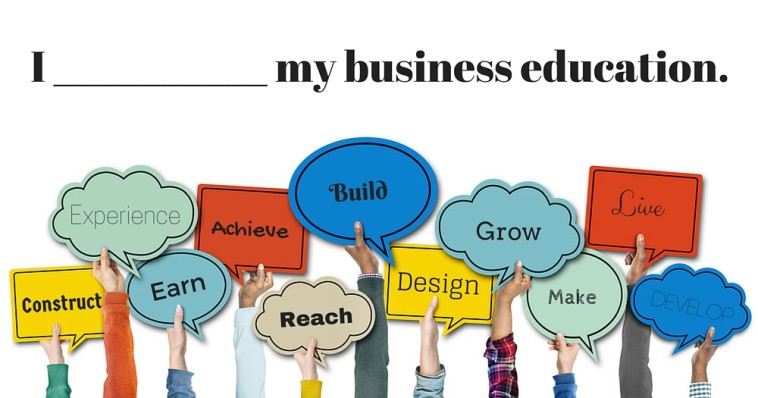
I’ve written lots of blog articles about business education, and I’ve spent lots of time trying to find the right words to describe the process of educating oneself using MOOCs and other new tools.
I must say, I am downright frustrated with the limitations of the English language when it comes to talking about education.
What do I mean?
I’m talking about the fact that the three most common verbs used in conjunction with education are the three least descriptive, most boring verbs in English.
Go. Do. Get.
A student goes to a university.
She does an MBA.
She gets a degree.
These words completely hide the richness of the educational process. Not only that, these verbs are awkward when it comes to talking about an education that doesn’t result in a degree, or that isn’t administered by an institution.
Do, go, and get are bound up with the idea that education is a thing. You go to a place, do some tasks that are assigned to you, and you get a piece of paper that is commonly recognized to be a valuable signal of your preparation. That’s education in a nutshell, right?
Well, I’m here to challenge these verbs and the idea of education that is encapsulated within them. I would like to propose three new verbs (and some related synonyms) to talk about education not as a thing, but as a process in which the learner is an active participant, not a passive recipient.
EXPERIENCE. BUILD. ACHIEVE.
Education isn’t about GOING to a university; it’s about EXPERIENCING transformation.
The word GO fails to capture the richness of transformative education. You don’t just go, you BECOME someone you weren’t when you first showed up for your education. You ARRIVE at a destination, though not necessarily a physical one. GO misses the moments of inspiration and insight that occur, the relationships that form, the horizons that open up as a result of education. You don’t just GO to school, you LIVE through an educational experience. Education ACTIVATES you. You CHANGE, GROW, TRANSFORM, and EVOLVE.
GO is also inadequate given the fact that contemporary education doesn’t require you to go anywhere in particular. Going to Harvard sounds cool, but to my mind, EXPERIENCING Harvard sounds even cooler. And new technologies are making that possible. Watch this video to see what I mean.
Rather than DO a degree, why not BUILD a body of knowledge?
Of course, when you undertake an education, you are DOING something. But what are you doing exactly? In Spanish, ‘to do’ and ‘to make’ are the same verb. In the case of education, I think the word MAKE is a much better translation. Education is something that the learner CONSTRUCTS inside his or her head. Education has to be FORMED, DEVELOPED, CULTIVATED.
Knowledge is BUILT not received. Therefore, I’m not just DOING an MBA or its equivalent. I am CONSTRUCTING a set of skills and knowledge, DESIGNING projects to solidify my learning, CRAFTING the education that is most valuable and relevant to me.
Instead of GETTING an education, how about ACHIEVING education, understanding, or even mastery?
GET is the worst. GET makes it sound like your education is simply handed to you. Or as if education is something you can buy, like a product in a store. But as any serious student knows, education can’t just be exchanged in a monetary transaction. By the same token, real learning can most certainly take place in the absence of a transactional relationship. Who’s to say that Josh Kaufman’s book-based education is any less valid than a business degree that another person paid $150,000 for? Is it the transaction that makes it count? I don’t think so. GET makes it sound like a sale or deal is the only path to learning.
Instead of GETTING an education (or TAKING a course), wouldn’t it be better to ATTAIN, ACCOMPLISH, EARN, REACH, or ARRIVE at an education?
Which words do YOU use?
In my No-Pay MBA, I’m not just GOING online to take some courses and GET a few certificates. I’m not just DOING a replica of an MBA.
I’m actively BUILDING new skills and knowledge, EXPERIENCING a transformation in the way I think about business, and ACHIEVING mastery across a variety of business disciplines.
What about you? What verbs do you use to talk about your education?
by Laurie Pickard | Oct 12, 2015 | MOOC MBA Design, Most popular posts

This question has been on my mind for some time:
Should No-Pay MBA have a different name?
Here’s the thing: No-Pay MBA is not and has never been truly “no-pay.” When I started this project, my goal was to find out if it was possible to get a complete business education, equivalent to an MBA, using free online courses.
When the name “No-Pay MBA” occurred to me, it just felt right.
But I never expected my education not to cost anything at all.
Even at the very beginning, back when MOOC platforms weren’t charging for certificates, I knew there would be some expenses associated with my courses. Things like setting up a website (not free), buying books and other course materials (not expensive, but not free), and securing a high-speed internet connection in Central Africa (definitely not free!). Throughout my studies, I have paid for course content, career coaching, and many other non-free things, all of which have been vital to my education.
Given everything I’ve spent money on, No-Pay MBA has never been a 100% accurate name for the project I have undertaken. That was okay when this was just a blog site. However, when I launched a business in July of this year, the name “No-Pay MBA” started to seem like a potential source of confusion. Indeed, I’ve fielded more than one inquiry to the effect of, “If this is the No-Pay MBA, why do you charge?” (I answer that in the FAQs, by the way.)
Even a No-Pay MBA requires a budget
“No-Pay” is by no means an ideological stance on my part. Quite the opposite, to make an honest attempt at getting an MBA-level education, I think it is absolutely critical to have some sort of budget. I typically recommend $1000 US as a bare minimum. The audience I am seeking to reach is primarily made up of people who have seriously considered traditional MBA programs but have decided that the price is just too high. One-thousand dollars is a pittance compared to what many in that audience have contemplated spending on a business education, especially if they live in the US. It’s not “no-pay,” but when compared to the price of a traditional MBA it feels pretty close to it. For that amount of money you can get access to the course content you need, a few certificates to adorn your portfolio, and even be part of No-Pay MBA’s network of business students.
If you have more than $1000 to put towards your education, you can consider all kinds of enriching experiences - such as conferences, travel, in-person professional training, and coaching. But I understand that for many people, even $1000 is a serious sum, which is another reason I have begun to question whether “No-Pay MBA” makes sense as a name.
It’s all about return on investment
For me, it’s not about how much you spend; it’s about the return on investment. Before I started my No-Pay MBA, I had the feeling that an investment of $150,000 - $200,000 wouldn’t make sense for me. After taking a few finance courses, I was able to explain in precise terms why that was true. And it’s all about return. Given the work I am interested in doing, a business education that expensive wouldn’t provide a good enough return.
Business school - even the most expensive program - can be a great investment, IF you plan to get a job that a) requires an MBA, and b) pays well enough to offset the cost of the education. If one or both of those isn’t true for you, a traditional MBA may not be your answer. But a lower-cost business education might still be a great investment, even if it isn’t free. As someone who works in international development, that was certainly the case for me.
If you need a business education to advance in your career, I want to help you make the best decision on how to get that education. I want you to understand all the options that are out there, many of which have only come into existence in the past few years. None of the good options are totally free, though many of them are quite affordable. That kind of nuance isn’t captured in the name “No-Pay MBA.”
So I’m putting it out to my readers.
Should No-Pay MBA’s name be changed?
I would be sad to change our name. I have built a reputation and some brand equity with this name. Also, I just really like No-Pay MBA. It’s catchy, and it rhymes. Low-Pay MBA rhymes too, but it doesn’t have quite the same ring. Real Life MBA is already taken. $1000 MBA is too literal. High-Return, Low Cost MBA Equivalent is as well.
But I want to hear from YOU.
Do you think No-Pay MBA would be better served with a different name?
A name that makes it clear not to expect the education I’m promoting to be truly and totally free?
If so, what should that name be?
I want to hear your ideas.
You can share them here.
by Laurie Pickard | Aug 23, 2015 | Career Development, MOOC MBA Design, Most popular posts
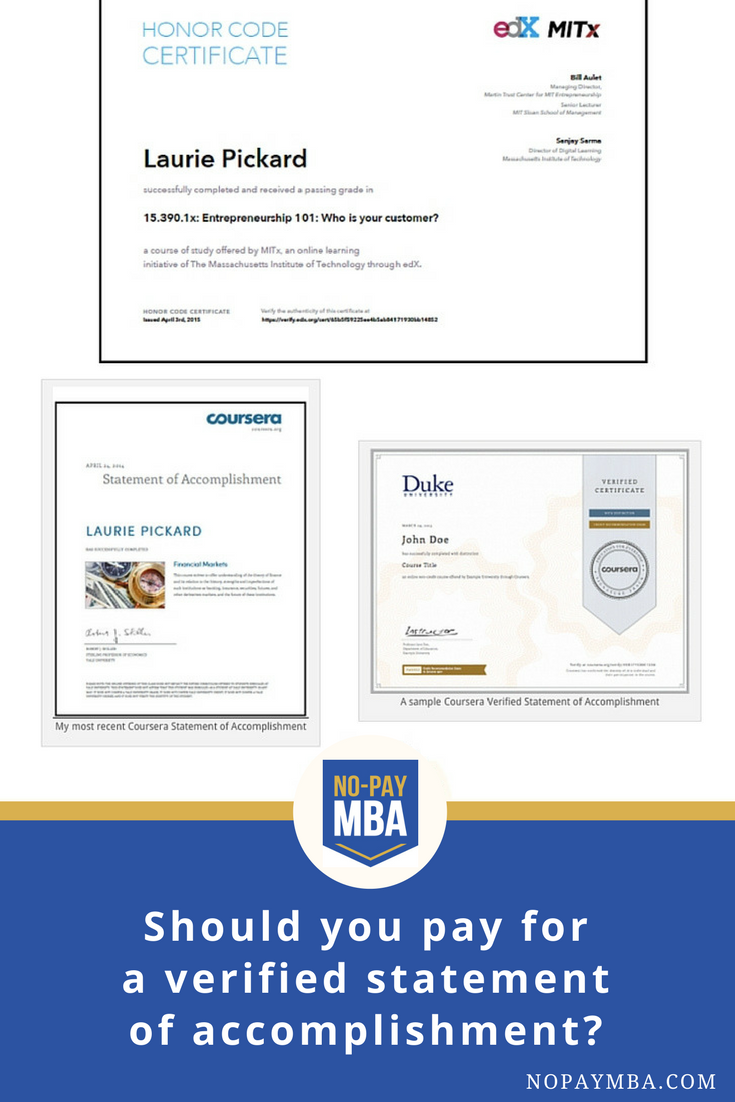
A lot has changed since I last wrote a post on whether you should pay for a verified certificate from a MOOC. If you’re just finding me now, my project is to use massive open online courses – MOOCs – to get an education equivalent to an MBA, at a fraction of the cost of a regular MBA degree. I don’t plan to receive any sort of credential for my studies, but I have sought to publicly demonstrate my efforts and my accomplishments, mainly through this website.
Back when I started my No-Pay MBA, all certificates were free. First Coursera and then edX introduced an identity-verified certificate for a fee, but these two major MOOC providers were still giving away honor-code certificates for free to anyone who completed all the requirements of their courses. At that time, I didn’t see much additional value for an identity-verified certificate over a non-identity verified one. So although I’ve taken over 25 MOOCs to date and have racked up a virtual stack of Statements of Accomplishment and Honor Code Certificates, I haven’t yet paid for a single one .
But things have changed in the world of MOOCs. Coursera is no longer offering free certificates in any of its courses. It’s $49 (or more) for an identity-verified certificate, or no certificate at all. EdX is moving in a similar direction, though in some of their courses it is still possible to get a free Honor Code Certificate. I’m a huge fan of MOOCs and MOOC providers; they’re providing an incredibly valuable service to learners all over the world. Charging for proof that you completed a course seems a smart move on their part. But it does pose a challenge for people like me.
I’ve set my benchmark at $1000 for a complete MBA education. If you’re going to start paying for certificates for every course, the $1000 MBA education becomes untenable pretty quickly. While I’ve called my project the No-Pay MBA, I’m not at all opposed to paying for elements of the world-class education I’m getting. I am, however, very discerning about how to allocate my scarce resources. If you’re taking an entire degree’s worth of courses and you start paying for certs at $50 a pop, (up to $100 for some courses), before long you’re looking at some serious cash. There is a lot I could do with $4,000, and I’m not sure that spending that money on course certificates is the best use of my money.
Last time I posted on this topic, my contention was that employers and most other people you’d want to present with your MOOC-based studies wouldn’t know the difference between the two kinds of certificates. I stand by that assertion, since I imagine it’s unclear even for many MOOC students.
Let me break it down for you. To receive an identify-verified certificate (which is what both Coursera and edX are selling in their courses), in addition to paying for the certificate the student has to prove their identify on each login to the system. This is done using photos taken by webcam and matched to a government-issued ID. Students also log a typing pattern, for subsequent verification.
As I’ve said before, I’m not sure any employers would dig deep enough to know or care about the difference between verified and non-verified certificates. However, if you claim to have taken courses that make you a more valuable employee, they may very well want to see some sort of proof. Regardless of who you’re hoping to impress, I do see some value in having a certificate to hang on your virtual wall, whether that wall is your LinkedIn profile, your resume, or your portfolio here on No-Pay MBA.
So what should you do?
Here is my updated advice for MOOC students in the brave new world of no free certificates.
Get certificates for some, but not all of your courses
If you’re only planning to take a few courses, you may want to get certificates for all of them. But if you’re taking many courses, be selective and choose just a few courses for which you’ll seek certificates. People’s eyes tend to glaze over after looking at about 5 certificates. Once you’ve demonstrated with a small number of certificates that you are capable of succeeding in online courses, you can more easily make the case that you’ve completed other valuable course work for which you didn’t seek certification.
Think in terms of skill sets
Rather than acquiring a random set of certificates for courses that bear no relationship to one another, use your certificates to demonstrate mastery of a skill set. Five intro-level certificates on different subjects are far less impressive than certificates for a series of five courses that build towards mastery. You might want to rely on specializations or series put together by the MOOC providers, or design your own course series.
Pair certificates with work examples in your portfolio
A powerful way to boost the value of any single certificate is to present the certificate alongside examples of the work you have done as a result of your coursework. Increasingly, portfolios are valued more highly than resumes. When you present evidence of your abilities next to your certificates, you make a compelling case that your education means something. The portfolio feature on No-Pay MBA is set up this way for a reason! Choose certificates that you can back up with a tangible project, whether or not you complete the project as part of the course itself.

Use loss aversion to your advantage
People who purchase certificates tend to finish their courses at a much higher rate than those who don’t. There are many reasons why this might be the case; perhaps those people who paid for certificates were more motivated or committed to the course to begin with. But there is also a robust literature in psychology to suggest that people don’t like to pay for something and then not get full value from it, whether or not there is any chance for the money to be refunded. Anecdotally, many MOOC students have commented on this blog that paying for certificates helps keep them motivated. Therefore, if there is a course you really want to take but are worried you might have difficulty finishing, that is precisely the course certificate you should be paying for.
Explore alternative payment arrangements
Coursera offers financial aid to students who make a compelling case that they need help to pay for their courses. Another strategy is to approach your current employer to find out if they would be willing to provide training to you in MOOC form. Fifty or $100 is not a lot of cash when compared to other methods of employee training. Your employer may also be impressed by your initiative, especially if you can tie your proposed course of study to tangible outcomes that benefit the company.
My last blog post on this topic generated a lot of discussion about the value of certificates. If you’ve been following the conversation, or if you’re new on this site, let’s hear your take. Do you pay for verified MOOC certificates?


